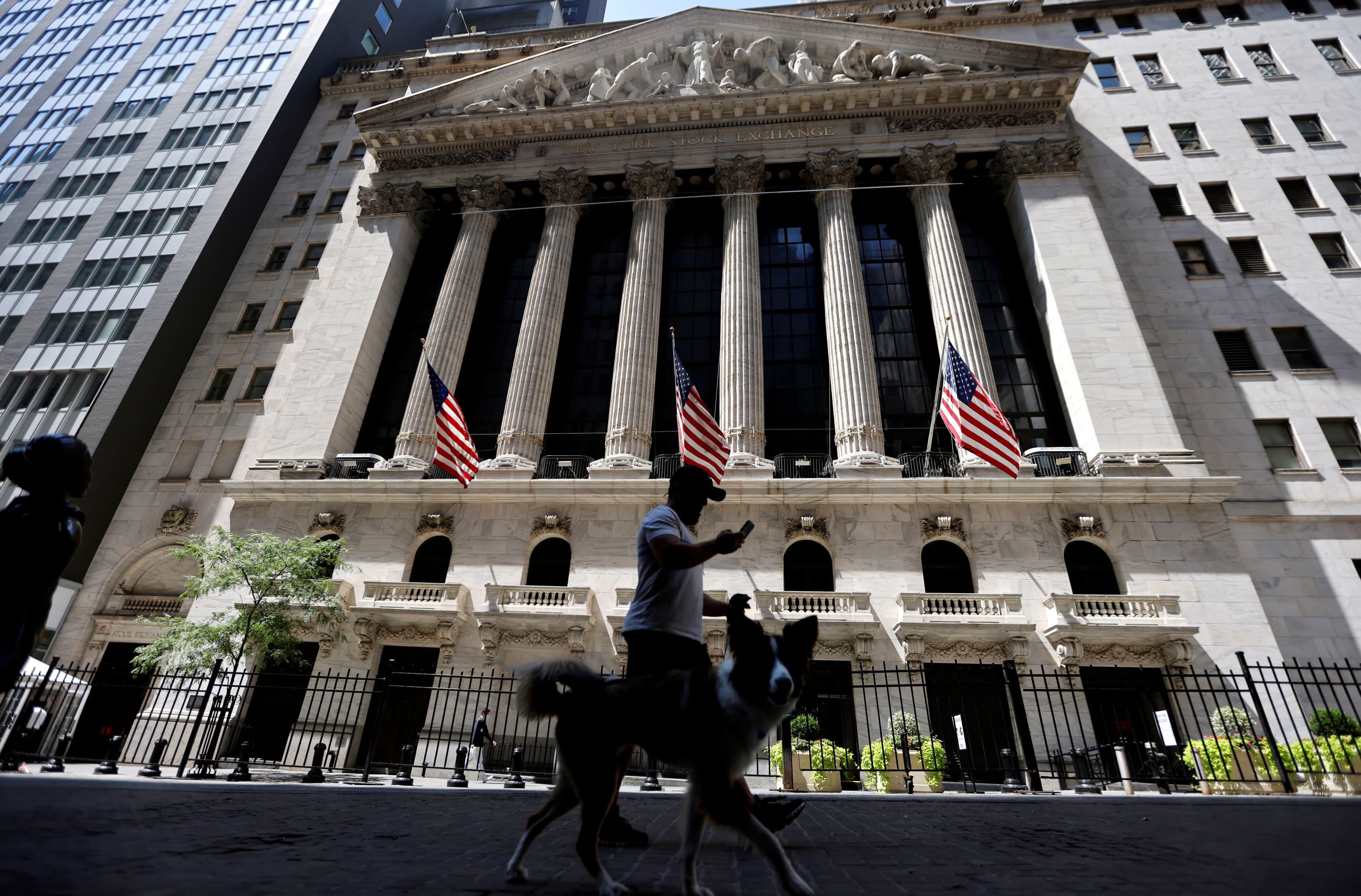
A man walks a dog in the shade away from the midday sun past the New York Stock Exchange (NYSE) building in Manhattan, during hot weather in New York City, New York, U.S., August 11, 2020.
Mike Segar | Reuters
President Donald Trump’s health and the state of a fiscal stimulus package will be the main focus for markets in the coming week.
In the early morning hours Friday, President Donald Trump tweeted that he and the first lady tested positive for Covid. Stocks sold off hard, but the S&P 500 came off its lows in Friday trading and closed down just under 1%. It was up 1.5% for the week.
The market was helped by signs that a stimulus package is still a possibility, after House Speaker Nancy Pelosi asked airlines not to furlough workers. She promised either a stand alone aid bill, or a bigger negotiated relief legislation that would help the industry.
“The market is going to watch health updates from the White House medical staff, and it’s going to watch how the president communicates with the public,” said Julian Emanuel, head of equities and derivatives at BTIG. “Will we see him in person in the next week in any form? What’s his volume of tweets? All as a way to first gauge the severity of the case.”
Trump and Melania Trump are reported to have mild cases, but as time goes on the market will turn to how the illness could impact the presidential election.
Former Vice President Joe Biden gained slightly in the polls after the first debate Tuesday night, and now the calendar for further debates is in question. The market has seemingly warmed to Biden, and even though he would raise taxes, it is assumed Democrats would quickly pass a major infrastructure package if there is a Democratic sweep of Congress.
Trump, however, is widely seen on Wall Street as stronger on the economy and better for markets.
“What you’ve done from a campaign perspective, is you’ve taken away the thing that gives him the most energy – his ability to interact with crowds,” said Emanuel. “The president had wanted to paint the economic recovery of the last three or four months as the cornerstone, and this basically puts the virus back as topic number 1, number 2 and number 3. And it’s all the more so because the data is coming in weaker than expected.”
The market is fixated on the prospect of stimulus to help business, the unemployed and state and local governments. The House passed a $2.2 trillion package this week, but there is still no agreement with Republicans. Treasury Secretary Steven Mnuchin has pushed for a $1.6 trillion package.
“I think there’s an underlying bid under the market because nobody wants to be super short if we get a stimulus approved, but you can’t be too long in case his mild symptoms turn into severe symptoms,” said Scott Redler, partner with T3live.com. “We’re in a tough spot but overall we’re still pretty constructive.”
Emanuel said the fact the president is now ill could hurt confidence and slow down some of the improvement in the economy.
“The underlying tone is, again, whether its directly or later, there’s going to be stimulus,” Emanuel said. “‘Whether it’s this month or November, this reinforces the need for stimulus because the president falling ill signals to, at the margin, the person whose thinking about going out to dinner to think again. It’s a significant economic and psychological hindrance.”
Also coming up in the week ahead is a speech Tuesday by Fed Chairman Jerome Powell to the National Association of Business Economists.
Powell is also expected to push for the stimulus package to boost the economy so the recovery does not stall.
“I think his whole objective is to try to get Congress and the Administration to sign onto a fiscal rescue package,” said Mark Zandi, chief economist at Moody’s Analytics. “He’ll all but come out and say [the recovery] is not a ‘V.’ Without additional support from lawmakers, risks are pretty high that we backtrack. I think that’s the kind of outlook he’s going to give. It’s going to be full-throated.”
September’s employment report, released Friday, was seen by some as a warning that the economy is not rebounding as expected. There were 661,000 jobs added in September, well below the 800,000 expected.
Besides Powell, there are a half dozen other Fed speakers. There are also minutes from the Fed’s last minute released Wednesday afternoon.
Week ahead calendar
Monday
9:45 a.m. Services PMI
10:00 a.m. ISM nonmanufacturing
10:45 a.m. Chicago Fed President Charles Evans
3:15 p.m. Atlanta Fed President Raphael Bostic
Tuesday
8:30 a.m. International trade
10:00 a.m. JOLTS
10:40 a.m. Federal Reserve Chairman Jerome Powell at NABE
Wednesday
1:00 p.m. Atlanta Fed’s Bostic
2:00 p.m. Fed minutes
2:00 p.m. New York Fed President John Williams
2:15 p.m. Minneapolis Fed President Neel Kashkari
2:40 p.m. Kashkari, Bostic, and Boston Fed President Eric Rosengren on panel
3:00 p.m. Consumer credit
3:00 p.m. New York Fed’s Williams
3:20 p.m. Boston Fed’s Rosengren
4:30 p.m. Chicago Fed’s Evans
Thursday
8:30 a.m. Initial jobless claims
Friday
10:00 a.m. Wholesale trade




